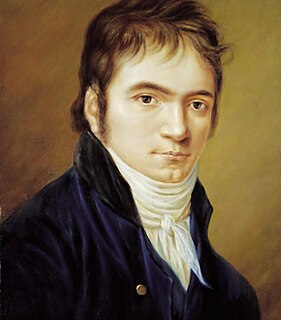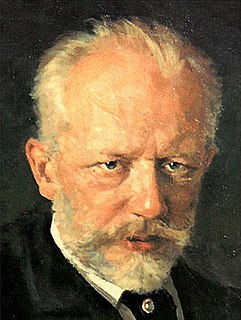Related Research Articles
The Symphony No. 94 in G major is the second of the twelve London symphonies written by Joseph Haydn. It is popularly known as the Surprise Symphony.

The Symphony No. 2 in D major, Op. 36, is a symphony in four movements written by Ludwig van Beethoven between 1801 and 1802. The work is dedicated to Karl Alois, Prince Lichnowsky.
Ludwig van Beethoven's Piano Sonata No. 3 in C major, Op. 2, No. 3, is a sonata written for solo piano, composed in 1795. It is dedicated to Joseph Haydn and is often referred to as Beethoven's first virtuosic piano sonata. The three Op. 2 sonatas all contain four movements each, an unusual length which seems to show that Beethoven was aspiring towards composing a symphony. It is both the weightiest and longest of the three Op. 2 sonatas, lasting over 25 minutes, presenting many difficulties, including difficult trills, awkward hand movements, and forearm rotation. It is Beethoven's second longest piano sonata in his early period, only to Beethoven's Grand Sonata in E♭ Major, Op. 7, published a year later.
Ludwig van Beethoven composed his Piano Sonata No. 12 in A♭ major, Op. 26, in 1800–1801, around the same time as he completed his First Symphony. He dedicated the sonata to Prince Karl von Lichnowsky, who had been his patron since 1792.
The two Serenades, Op. 11 and 16, represent early efforts by Johannes Brahms to write orchestral music. They both date from after the 1856 death of Robert Schumann when Brahms was residing in Detmold and had access to an orchestra.

Ludwig van Beethoven's String Quartet No. 10 in E-flat major, Op. 74, was written in 1809 and is nicknamed the "Harp" quartet.

Pyotr Ilyich Tchaikovsky's Symphony No. 3 in D major, Op. 29, was written in 1875. He began it at Vladimir Shilovsky's estate at Ussovo on 5 June and finished on 1 August at Verbovka. Dedicated to Shilovsky, the work is unique in Tchaikovsky's symphonic output in two ways: it is the only one of his seven symphonies in a major key ; and it is the only one to contain five movements.
Piano Sonata No. 13 in E-flat major, Op. 27 "Quasi una fantasia", No. 1, is a sonata composed by Ludwig van Beethoven in 1800–1801.
The Piano Sonata No. 3 in F minor, Op. 5 of Johannes Brahms was written in 1853 and published the following year. The sonata is unusually large, consisting of five movements, as opposed to the traditional three or four. When he wrote this piano sonata, the genre was seen by many to be past its heyday. Brahms, enamored of Beethoven and the classical style, composed Piano Sonata No. 3 with a masterful combination of free Romantic spirit and strict classical architecture. As a further testament to Brahms' affinity for Beethoven, the Piano Sonata is infused with the instantly recognizable motive from Beethoven's Symphony No. 5 during the first, third, and fourth movements. Composed in Düsseldorf, it marks the end of his cycle of three sonatas, and was presented to Robert Schumann in November of that year; it was the last work that Brahms submitted to Schumann for commentary. Brahms was barely 20 years old at its composition. The piece is dedicated to Countess Ida von Hohenthal of Leipzig.
Symphony No. 76 in E♭ major is a symphony by Joseph Haydn completed in 1782.
Western Symphony is a ballet made by New York City Ballet co-founder and founding choreographer George Balanchine to American folk tunes arranged by Hershy Kay. It premiered on September 7, 1954 at the City Center of Music and Drama in New York. The ballet was originally presented in practice clothes without scenery. Scenery by John Boyt and costumes by Karinska were added in 1955. Lighting was originally by Jean Rosenthal and subsequently Mark Stanley. Set in the Western United States, the ballet features cowboys and dance hall girls.

Schubert's Symphony No. 10 in D major, D 936A, is an unfinished work that survives in a piano sketch. Written during the last weeks of the composer's short life, it was only properly identified in the 1970s. It has been orchestrated by Brian Newbould in a completion that has subsequently been performed, published and recorded.
Zakouski is a ballet made by New York City Ballet ballet master in chief Peter Martins to:
Nikolaj Hübbe is artistic director of the Royal Danish Ballet.
The Op. 33 String Quartets were written by Joseph Haydn in the summer and Autumn of 1781 for the Viennese publisher Artaria. This set of quartets has several nicknames, the most common of which is the "Russian" quartets, because Haydn dedicated the quartets to the Grand Duke Paul of Russia and many of the quartets were premiered on Christmas Day, 1781, at the Viennese apartment of the Duke's wife, the Grand Duchess Maria Feodorovna.
The Symphony No. 6 by Walter Piston was completed in 1955.
Marcel Tyberg was an Austrian composer, conductor and organist. His music is late-Romantic in style.

The Piano Quartet No. 2 in A major, Op. 26, by Johannes Brahms is scored for piano, violin, viola and cello. It was completed in 1861 and received its premiere in November 1863 by the Hellmesberger Quartet with the composer playing the piano part. It has been especially noted for drawing influence from composer Franz Schubert. Lasting approximately 50 minutes, this quartet is the longest of Brahms's chamber works to perform. He also made an arrangement of this quartet for two pianos.
Sonatas, duos and fantasies by Franz Schubert include all works for solo piano by Franz Schubert, except separate dances. They also include a number of works for two players: piano four hands, or piano and a string instrument.

Symphony No. 12 is a composition by the Brazilian composer Heitor Villa-Lobos, written in 1957. A performance lasts about twenty-five minutes.
References
- Playbill , New York City Ballet, Wednesday, April 30, 2008
- Repertory Week, New York City Ballet, Spring Season, 2008 repertory, week 1